Ecological Security Pattern Construction in Beijing-Tianjin-Hebei Region Based on Hotspots of Multiple Ecosystem Services
Abstract
:1. Introduction
2. Materials and Methods
2.1. Study Area
2.2. Data Sources
2.3. Methods
2.3.1. Ecosystem Services Indicators
2.3.2. CA_Markov Model
- The Markov model is used to calculate the land use type under the “possible state”, and the area quantity or proportion of mutual transformation of land use types is regarded as a state transition probability. This probability is used to predict the change state of land use structure. The specific formula is as follows:where S(T) is the state of land use structure at time T, and Pij is the state transition matrix.S (T) = Pij + S (T0)
- A 5 × 5 CA filter (is) is constructed to analyze the influence of the rectangular space composed of 5 × 5 cells around the cell on the state change of the cell, and a weight factor with significant spatial significance is established [54], which is expressed as follows:where S is the finite and discrete set of cellular states, N is the domain of cellular, and f is the transformation rule of cellular states in local space.S (t + 1) = f (St, N)
- The starting time of prediction period and the number of CA cycles were determined. Based on the 2000–2015 transfer matrix of BTH region, the number of CA iterations was set as 15 to simulate the land use pattern of BTH region in 2030. Kappa index was used to test the accuracy of the initial transfer pattern changes [53]. A comparison was carried out between the predicted and actual land use in 2015. The Kappa coefficient value is 0.91, which represents a good simulation result. Thus, the verified CA_Markov can be used to predict land use type in 2030.
2.3.3. Hotspot Analysis
2.3.4. Minimum Cumulative Resistance
3. Results
3.1. Spatio-Temporal Characteristic of Ecosystem Services in BTH
3.2. Analysis on the Driving Factor of Ecosystem Service Variation
3.2.1. Impacts of Climate Change on Ecosystem Services
3.2.2. Impact of Land Use Change on Ecosystem Services
3.3. Identification of Ecosystem Services Hotspots from 2000 to 2030
3.4. Identification of Ecological Security Pattern
4. Discussions
4.1. The Discussions on Driving Factor Analysis
4.2. The Discussions on Hotspots Analysis
4.3. Linking Ecological Security Pattern and Planning Strategy in BTH
5. Conclusions
Supplementary Materials
Author Contributions
Funding
Institutional Review Board Statement
Informed Consent Statement
Data Availability Statement
Conflicts of Interest
References
- Zheng, H.; Wang, L.; Peng, W.; Zhang, C. Realizing the values of natural capital for inclusive, sustainable development: Informing China’s new ecological development strategy. Proc. Natl. Acad. Sci. USA 2019, 116, 8623–8628. [Google Scholar] [CrossRef] [PubMed] [Green Version]
- Millennium Ecosystem Assessment. Ecosystems and Human Well-Being: Synthesis; Island Press: Washington, DC, USA, 2005. [Google Scholar]
- La Notte, A.; D’Amato, D.; Mäkinen, H.; Maria, L.P.; Camino, L.; Benis, E.; Davide, G.; Neville, D.C. Ecosystem services classification: A systems ecology perspective of the cascade framework. Ecol. Indic. 2017, 74, 392–402. [Google Scholar] [CrossRef] [PubMed]
- Brito, I.; Goss, M.J.; Carvalho, M.D.; Chatagnier, O.; Tuinen, D. Impact of tillage system on arbuscular mycorrhiza fungal communities in the soil under Mediterranean conditions. Soil Till. Res. 2012, 12, 63–76. [Google Scholar] [CrossRef]
- Newbold, T.; Hudson, L.N.; Hill, S.L.L.; Contu, S.; Lysenko, I.; Senior, R.A.; Börger, L.; Bennett, D.J.; Choimes, A.; Collen, B.; et al. Global effects of land use on local terrestrial biodiversity. Nature 2015, 520, 45–50. [Google Scholar] [CrossRef] [Green Version]
- Nicu, C.T.; Roger, C.; Annelies, B.; Anabel, S.; Hermine, M.; Mirabela, M. Mainstreaming the nexus approach in climate services will enable coherent local and regional climate policies. Adv. Clim. Change Res. 2021, 12, 752–755. [Google Scholar] [CrossRef]
- IPBES; Willemen, L. Summary for policymakers of the assessment report on land degradation and restoration of the Intergovernmental Science-Policy Platform on Biodiversity and Ecosystem Services; IPBES Secretariat: Bonn, Germany, 2018; Available online: https://ipbes.net/assessment-reports/asia-pacific (accessed on 30 December 2020).
- Koppelmki, K.; Lamminen, M.; Helenius, J.; Schulte, R. Smart integration of food and bioenergy production delivers on multiple ecosystem services. Food Energy Secur. 2021, 10, 2048–3694. [Google Scholar] [CrossRef]
- Kumar, D.; Choudhury, M.; Rathore, A. Valuation of Ecosystem Services & Benefits of Son Beel Wetland in Assam, India: A Case Study of Natural Solutions to Climate Change & Water. SSRN Electron. J. 2020. [Google Scholar] [CrossRef]
- Wen, X.; Theau, J. Spatiotemporal analysis of water-related ecosystem services under ecological restoration scenarios: A case study in northern Shaanxi, China. Sci. Total Environ. 2020, 720, 137477.1–137477.13. [Google Scholar] [CrossRef]
- Nelson, E.; Mendoza, G.; Regetz, J.; Polasky, S.; Tallis, H.; Cameron, D.; Chan, K.M.; Daily, G.C.; Goldstein, J.; Kareiv, P.M.; et al. Modeling multiple ecosystem services, biodiversity conservation, commodity production, and tradeoffs at landscape scales. Front. Ecol. Environ. 2009, 7, 4–11. [Google Scholar] [CrossRef]
- Cabral, P.; Clément, F.; Levrel, H.; Chambolle, M.; Basque, D. Assessing the impact of land-cover changes on ecosystem services: A first step toward integrative planning in Bordeaux, France. Ecosyst. Serv. 2016, 22, 318–327. [Google Scholar] [CrossRef] [Green Version]
- Bai, Y.; Ochuodho, T.O.; Yang, J. Impact of land use and climate change on water-related ecosystem services in Kentucky, USA. Ecol. Indic. 2019, 102, 51–64. [Google Scholar] [CrossRef]
- Cardinale, B.J.; Duffy, J.E.; Gonzalez, A.; Hooper, D.U.; Perrings, C.; Venail, P.; Narwani, A.; Mace, G.M.; Tilman, D.; Wardle, D.; et al. Biodiversity loss and its impact on humanity. Nature 2012, 486, 59–67. [Google Scholar] [CrossRef] [PubMed]
- Hoyer, R.; Chang, H. Assessment of freshwater ecosystem services in the Tualatin and Yamhill basins under climate change and urbanization. Appl. Geogr. 2014, 53, 402–416. [Google Scholar] [CrossRef]
- Kusi, K.K.; Khattabi, A.; Mhammdi, N. Integrated assessment of ecosystem services in response to land use change and management activities in Morocco. Arab. Geosci. 2021, 14, 418. [Google Scholar] [CrossRef]
- Zhang, X.R.; Zhou, J.; Li, G.N.; Chen, C.; Li, M.M.; Luo, J.M. Spatial pattern reconstruction of regional habitat quality based on the simulation of land use changes from 1975 to 2010. J. Geogr. Sci. 2020, 30, 601–620. [Google Scholar] [CrossRef]
- Alexander, L.V.; Zhang, X.; Peterson, T.C.; Caesar, J.; Gleason, B.; Klein Tank, A.M.G.; Haylock, M.; Collins, D.; Trewin, B.; Rahimzadeh, F.; et al. Global Observed Changes in Daily Climate Extremes of Temperature and Precipitation. J. Geophys. Res. Atmos. 2006, 111, 1–22. [Google Scholar] [CrossRef] [Green Version]
- Thellmann, K.; Golbon, R.; Cotter, M.; Cadisch, G.; Asch, F. Assessing Hydrological Ecosystem Services in a Rubber-Dominated Watershed under Scenarios of Land Use and Climate Change. Forests 2019, 10, 176. [Google Scholar] [CrossRef] [Green Version]
- Liu, Z.; Yang, J.G.; Ma, L.H.; Ke, Z.M.; Hu, Y.M.; Yan, X.Y. Spatial-temporal trend of grassland net primary production and their driving factors in the Loess Plateau, China. Chin. J. Appl. Ecol. 2021, 32, 113–122. [Google Scholar] [CrossRef]
- Azam, M.; Khan, A.Q. Urbanization and environmental degradation:evidence from four SAARC countries-Bangladesh, India, Pakistan, and Sri Lanka. Environ. Prog. Sustain. 2016, 35, 823–832. [Google Scholar] [CrossRef]
- Fang, Y.S.; Zu, J.; Ai, D.; Chen, J.; Liang, Q.Y. Research on evaluation of the importance of ecological protection in Kunming city oriented to spatial planning. J. China Agric. Univ 2021, 26, 152–163. [Google Scholar] [CrossRef]
- Wu, J.G. Urban ecology and sustainability: The state-of-the-science and future directions. Landsc. Urban Plan. 2014, 125, 209–221. [Google Scholar] [CrossRef]
- Yu, K.J. Landscape ecological patterns in biological conservation. Acta Ecol. Sin. 1999, 19, 8–15. [Google Scholar] [CrossRef]
- Zhang, H.; Wang, A.Q.; Song, B.Y. Evaluation of Land Ecological Security in Dali City Based on OWA. Sci. Geogr. Sinica. 2017, 37, 1778–1784. [Google Scholar] [CrossRef]
- Tan, Q.H.; Zhang, J.T.; Zhou, X.S. Construction of Ecological Security Patterns Based on Minimum Cumulative Resistance Model in Nanjing City. Bull. Soil Water Conserv. 2020, 40282–40288, 40296, 40325. [Google Scholar] [CrossRef]
- Yu, C.L.; Liu, D.; Feng, R.; Tang, Q.; Guo, C.L. Construction of ecological security pattern in Northeast China based on MCR model. Acta Ecol. Sin. 2021, 41, 290–301. [Google Scholar] [CrossRef]
- Meng, J.J.; Wang, Y.; Wang, X.D. Construction of Landscape Ecological Security Pattern in Guiyang Based on MCR model. Resour. Environ. Yangtze Basin 2016, 25, 1052–1061. [Google Scholar] [CrossRef]
- Wang, Y.; Pan, J.H. Establishment of ecological security patterns based on ecosystem services value reconstruction in an arid inland basin: A case study of the Ganzhou District, Zhangye City, Gansu Province. Acta Ecol. Sin. 2019, 39, 3455–3467. [Google Scholar] [CrossRef]
- Liu, M.; Min, L.; Zhao, J.; Shen, Y.; Pei, H.; Zhang, H.; Li, Y. The Impact of Land Use Change on Water-Related Ecosystem Services in the Bashang Area of Hebei Province, China. Sustainability 2021, 13, 716. [Google Scholar] [CrossRef]
- Wang, B.S.; Chen, H.X.; Dong, Z.; Zhu, W.; Qiu, Q.Y.; Tang, L.N. Impact of land use change on the water conservation service of ecosystems in the urban agglomeration of the Golden Triangle of Southern Fujian, China, in 2030. Acta Ecol. Sin. 2020, 40, 484–498. [Google Scholar] [CrossRef]
- Liu, S.F.; Chen, J.M.; Guan, S.; Wang, H. Effect of Future Land Use Change on Water Conservation Function Based on InVEST Model—Taking Yangxi River Basin as an Example. J. Anhui Agric. Sci. 2020, 48, 67–70. [Google Scholar] [CrossRef]
- Wu, J.; Li, Y.H.; Huang, L.Y.; Lu, Z.M.; Yu, D.P.; Zhou, L.; Dai, L.M. Spatiotemporal variation of water yield and its driving factors in Northeast China. Chin. J. Ecol. 2017, 36, 3216–3223. [Google Scholar] [CrossRef]
- Ning, Y.Z.; Zhang, F.P.; Feng, Q.; Wei, Y.F.; Ding, J.B.; Zhang, Y. Temporal and spatial variation of water conservation service function in Qinling Mountain and its influencing factors. Chin. J. Ecol. 2020, 39, 3080–3091. [Google Scholar] [CrossRef]
- Wang, G.; Wang, L.; Wu, W. Recognition on regional ecological security definition and assessment system. Acta Ecol. Sin. 2007, 27, 1627–1637. [Google Scholar] [CrossRef]
- Li, P.F.; Liu, W.J.; Zhao, X.Y. The changes of atmospheric temperature, precipitation and potential evapotranspiration in Beijing—Tianjin—Hebei region in recent 50 years. J. Arid Land Resour. Environ. 2015, 29, 137–143. [Google Scholar] [CrossRef]
- Yan, S.J.; Wang, H.; Jiao, K.W. Spatiotemporal dynamic of NDVI in the Beijing-Tianjin-Hebei region based on MODIS data and quantitative attribution. J. Geo. Inf. Sci. 2019, 21, 767–780. [Google Scholar] [CrossRef]
- Zhai, Y.P.; Chen, Y.M.; Gao, J.X.; Song, T.; Feng, C.Y.; Nian, W. Division of Donor and Receptor Areas of Ecological Services of Water Conservation in Beijing-Tianjin-Hebei Region. Res. Environ. Sci. 2019, 32, 1099–1107. [Google Scholar] [CrossRef]
- Shi, M.; Wu, H.; Fan, X.; Jia, H.; Dong, T.; He, P.; Baqa, M.F.; Jiang, P. Trade-Offs and Synergies of Multiple Ecosystem Services for Different Land Use Scenarios in the Yili River Valley, China. Sustainability 2021, 13, 1577. [Google Scholar] [CrossRef]
- Haines, R.; Potschin, M. Revision of the Common International Classification for Ecosystem Services (CICES V5.1): A Policy Brief. One Ecosyst. 2018, 3, e27108. [Google Scholar] [CrossRef]
- Wong, C.P.; Jiang, B.; Kinzig, A.P.; Lee, K.N.; Ouyang, Z. Linking ecosystem characteristics to final ecosystem services for public policy. Ecol. Lett. 2015, 18, 108–118. [Google Scholar] [CrossRef] [PubMed] [Green Version]
- Li, D.; Sun, W.; Xia, F.; Yang, Y.; Xie, Y. Can Habitat Quality Index Measured Using the InVEST Model Explain Variations in Bird Diversity in an Urban Area? Sustainability 2021, 13, 5747. [Google Scholar] [CrossRef]
- Benra, F.; Frutos, A.D.; Gaglio, M.; Garretón, C.; Bonn, A. Mapping water ecosystem services: Evaluating InVEST model predictions in data scarce regions. Environ. Model. Softw. 2021, 104982. [Google Scholar] [CrossRef]
- Wang, L.X.; Li, M.M.; Qi, L.I.; Xu, X.L. Remote Sensing Estimation of NPP in Shaanxi Province based on CASA Model. J. West China. For. Sci. 2015. [Google Scholar] [CrossRef]
- Li, Y.Y.; Fan, J.H.; Liao, Y. Analysis of spatial and temporal differences in water conservation function in Zhangjiakou based on the InVEST model. Pratacult. Sci. 2020, 37, 1313–1324. [Google Scholar] [CrossRef]
- Zhou, B.; Yu, X.X.; Chen, L.H.; Zhang, Z.M.; Lv, X.Z.; Fan, M.R. Soil erosion simulation in mountain areas of Beijing based on InVEST Model. Res. Soil Water Conserv. 2010, 17, 9–13. [Google Scholar]
- Wischmeier, W.H.; Johnson, C.B.; Cross, B.V. Soil erodibility nomograph for farmland and construction sites. J. Soil Water Conserv. 1971, 26, 189–193. [Google Scholar] [CrossRef] [Green Version]
- Williams, J.R.; Jones, C.A.; Dyke, P.T. Modeling approach to determining the relationship between erosion and soil productivity. Trans. ASAE 1984, 27, 0129–0144. [Google Scholar] [CrossRef]
- Deng, Y.; Jiang, W.G.; Wang, W.J.; Lu, J.; Chen, K. Urban expansion led to the degradation of habitat quality in the Beijing-Tianjin-Hebei Area. Acta Ecol. Sin. 2018, 38, 4516–4525. [Google Scholar] [CrossRef]
- Shui, W.; Du, Y.; Wang, Y.N.; Yang, H.F.; Fu, Y.; Fan, B.X.; Huang, M.Y. Spatio-temporal dynamics and scenarios simulation of trade-offs between ecosystem services in Min Delta urban agglomeration. Acta Ecol. Sin. 2019, 39, 5188–5197. [Google Scholar] [CrossRef]
- Zhu, W.Q.; Pan, Y.Z.; He, H.; Yu, D.Y.; Hu, H.B. Simulation of maximum light use efficiency for some typical vegetation types in China. Chin. Sci. Bull. 2006, 51, 457–463. [Google Scholar] [CrossRef]
- Guan, D.J.; Gao, W.J.; Wateri, K. Land use change of Kitakyushu based on landscape ecology and Markov model. J. Geogr. Sci. 2008, 18, 455–468. [Google Scholar] [CrossRef]
- Zhou, T.J.; Ni, C.; Zheng, X. Study on the Impact of Landuse Pattern Changes on Habitat Based on Ca-Markov and InVEST Models—A Case Study of Shallow Mountainous Areas in Beijing. J. Chin. Landsc. Archit. 2020, 36, 139–144. [Google Scholar] [CrossRef]
- Dan, H.E.; Jin, F.J.; Zhou, J. The Changes of Land Use and Landscape Pattern Based on Logistic-CA-Markov Model—A Case Study of Beijing-Tianjin-Hebei Metropolitan Region. Sci. Geogr. Sin. 2011, 31, 903–910. [Google Scholar] [CrossRef]
- Dai, L.; Tang, H.; Zhang, Q.; Cui, F. The trade-off and synergistic relationship among ecosystem services:A case study in Duolun County, the agro-pastoral ecotone of Northern China. Acta Ecol. Sin. 2020, 40, 2863–2876. [Google Scholar] [CrossRef]
- Wang, J.L.; Zhou, W.Q.; Pickett, S.T.A.; Yu, W.J.; Li, W.F. A multiscale analysis of urbanization effects on ecosystem services supply in an urban megaregion. Sci. Total Environ. 2019, 662, 824–833. [Google Scholar] [CrossRef] [PubMed]
- Liu, J.L. Simulation and Temporal- Spatial Tradeoffs of Ecosystem Services: A Case Study in Beijing-Tianjin-Hebei Region. Beijing. Master’s Thesis, Peking University, Beijing, China, 2013. [Google Scholar]
- Wu, W.H.; Peng, J.; Liu, Y.X.; Hu, Y.N. Tradeoffs and synergies between ecosystem services in Ordos City. Prog. Geog. 2017, 36, 1571–1581. [Google Scholar] [CrossRef]
- Tang, P.; Wang, H. Analysis on the suitability of green sponge space in modern city based on MCR model. J. Nanjing For. Univ. 2019, 43, 116–122. [Google Scholar] [CrossRef]
- Wu, J.H.; Liu, S.Y.; Bai, S. Identification and optimization of ecological corridors in Shenmu city based on landscape ecological security. Arid. Land Res. 2021, 38, 1120–1127. [Google Scholar] [CrossRef]
- Xu, S.; Wang, P.; Kong, W.D. Mountainous Optimization of Ecological Security Pattern Based on MCR Model from the Perspective of Disaster Prevention: A Case Study of Beijing-Tianjin-Hebei Mountainous Area. J. Catastrophol. 2021, 36, 118–123. [Google Scholar] [CrossRef]
- Wang, Y.; He, C.; Liu, R.G.; Wu, H.B.; Chen, G.Q. Community structure of summer bird in Shapotou nature reserve, Ningxia. Acta Ecol. Sin. 2017, 37, 5531–5541. [Google Scholar] [CrossRef]
- Pan, M.; Chen, T.W.; Huang, L.; Cao, W. Spatial and temporal variations in ecosystem services and its driving factors analysis in Jing-Jin-Ji region. Acta Ecol. Sin. 2020, 40, 5151–5167. [Google Scholar] [CrossRef]
- Cui, F.; Wang, B.; Zhang, Q.; Tang, H.P.; Maeyer, P.D.; Hamdi, R.; Dai, L.W. Climate change versus land-use change—What affects the ecosystem services more in the forest-steppe ecotone? Sci. Total Environ. 2020, 759, 143525. [Google Scholar] [CrossRef]
- Li, G.; Fang, C.; Wang, S. Exploring spatiotemporal changes in ecosystem-service values and hotspots in China. Sci. Total Environ 2016, 545–546, 609–620. [Google Scholar] [CrossRef]
- Wang, B.; Zhao, J.; Hu, X.F. Spatial pattern analysis of ecosystem services based on InVEST in Heihe River Basin. Chin. J. Ecol. 2016, 35, 2783–2792. [Google Scholar] [CrossRef]
- Guo, C.Y.; Gao, S.; Zhou, B.Y.; Gao, J.H. Effects of land use change on ecosystem service value in Funiu Mountain based upon a grid square. Acta Ecol. Sin. 2019, 39, 3482–3493. [Google Scholar] [CrossRef]
- Pan, H.H.; Wu, S.R.; Yang, Z.Q.; Wu, Z.T.; Zhang, H. Spatiotemporal pattern of hotspots (coldspots) of ecosystem services in coal fields of Shanxi Province. Arid Land Grogr. 2022. Available online: https://kns.cnki.net/kcms/detail/65.1103.x.20210604.0840.002.html (accessed on 30 December 2020).
- Li, S.X. The Dynamics of Ecosystem Services and Their Driving Factors in the Jing-Jin-Ji Region. Ph.D. Thesis, The Beijing Forestry University, Beijing, China, 2019. [Google Scholar]
- Wang, Z.B.; Liang, L.W.; Fang, C.L.; Zhuang, R.L. Study of the evolution and factors influencing ecological security of the Beijing-Tianjin-Hebei Urban Agglomeration. Acta Ecol. Sin. 2018, 38, 4132–4144. [Google Scholar] [CrossRef]
- Liu, J.; Li, W.; Zhou, W.; Han, L.; Qian, Y. Prediction of expansion pattern and impact on regional ecological security of Beijing-Tianjin-Hebei Metropolitan Region. Acta Ecol. Sin. 2018, 38, 1650–1660. [Google Scholar] [CrossRef]
- Peng, J.; Li, H.L.; Liu, Y.X.; Hu, Y.N.; Yang, Y. Identification and optimization of ecological security pattern in Xiong’an New Area. Acta Grogr. Sin. 2018, 73, 701–710. [Google Scholar] [CrossRef]
- Hu, Q.H.; Cong, N.; Yin, G.D. Ecological security pattern construction in typical ecological shelter zone: A case study of Chengde. Chin. J. Ecol. 2021, 40, 2914–2926. [Google Scholar] [CrossRef]
- Li, C.; Zhang, X.; Xu, Y.; Wang, X.; Hao, F.H.; Yu, S.J. Study on ecological security under the influence of human activities in the ecological barrier zone in Beijing-Tianjin-Hebei region. China Environ. Sci. 2021, 41, 3324–3332. [Google Scholar]
- Zhou, B. Research on the Green Development Strategy of Northern Beijing Under the Background of 2022 Winter Olympic Games. Chi. J. Environ. Manag. 2018, 10, 121–125, 140. [Google Scholar] [CrossRef]
- Prudnikova, N. Environmental Problems and unintended consequences of the Winter Olympic Games: A case study of Sochi 2014. J. Policy Res. Tour. Leis. Events 2012, 4, 211–214. [Google Scholar] [CrossRef]
- Scalenghe, R.; Fasciani, G. Soil Heavy Metals Patterns in the Torino Olympic Winter Games Venue (E.U.). Soil. Sediment Contam. 2008, 17, 205–220. [Google Scholar] [CrossRef] [Green Version]
- Sobol, A.L. No medals for Sochi: Why the environment earned last place at the 2014 Winter Olympic Games, and how host cities can score a “green” medal in the future. Villanova Environ. Law J. 2015, 26, 169–192. [Google Scholar]
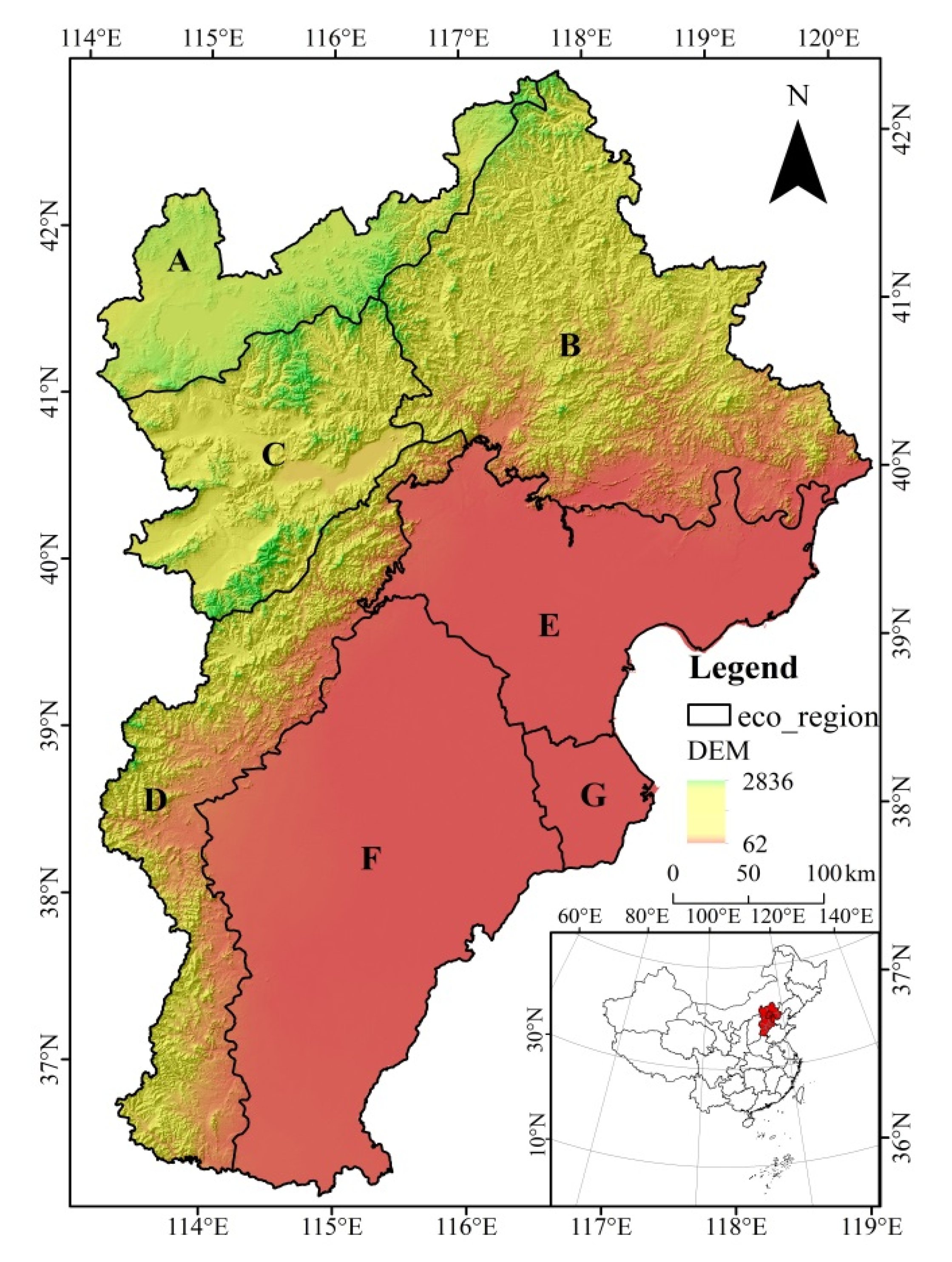
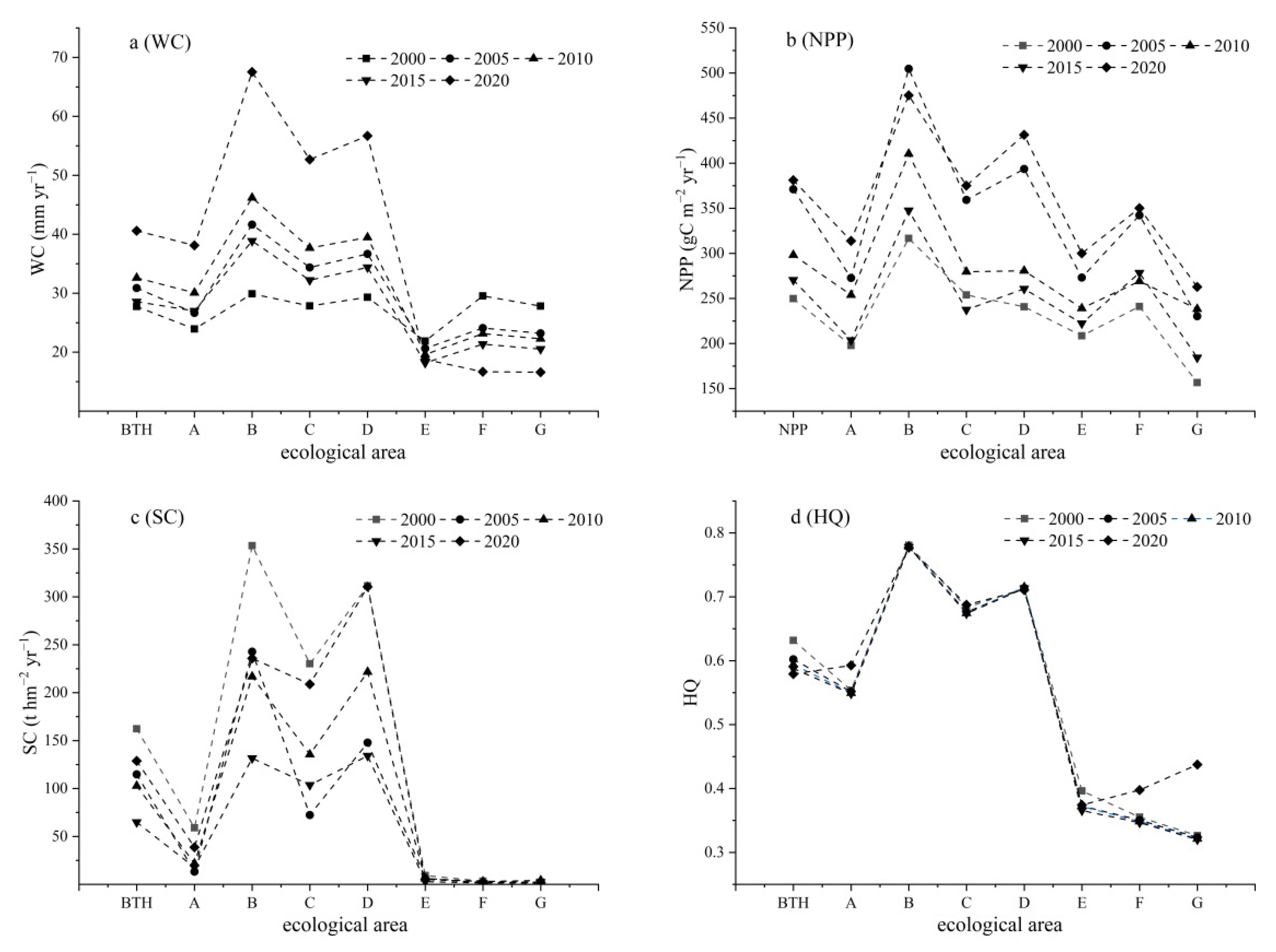
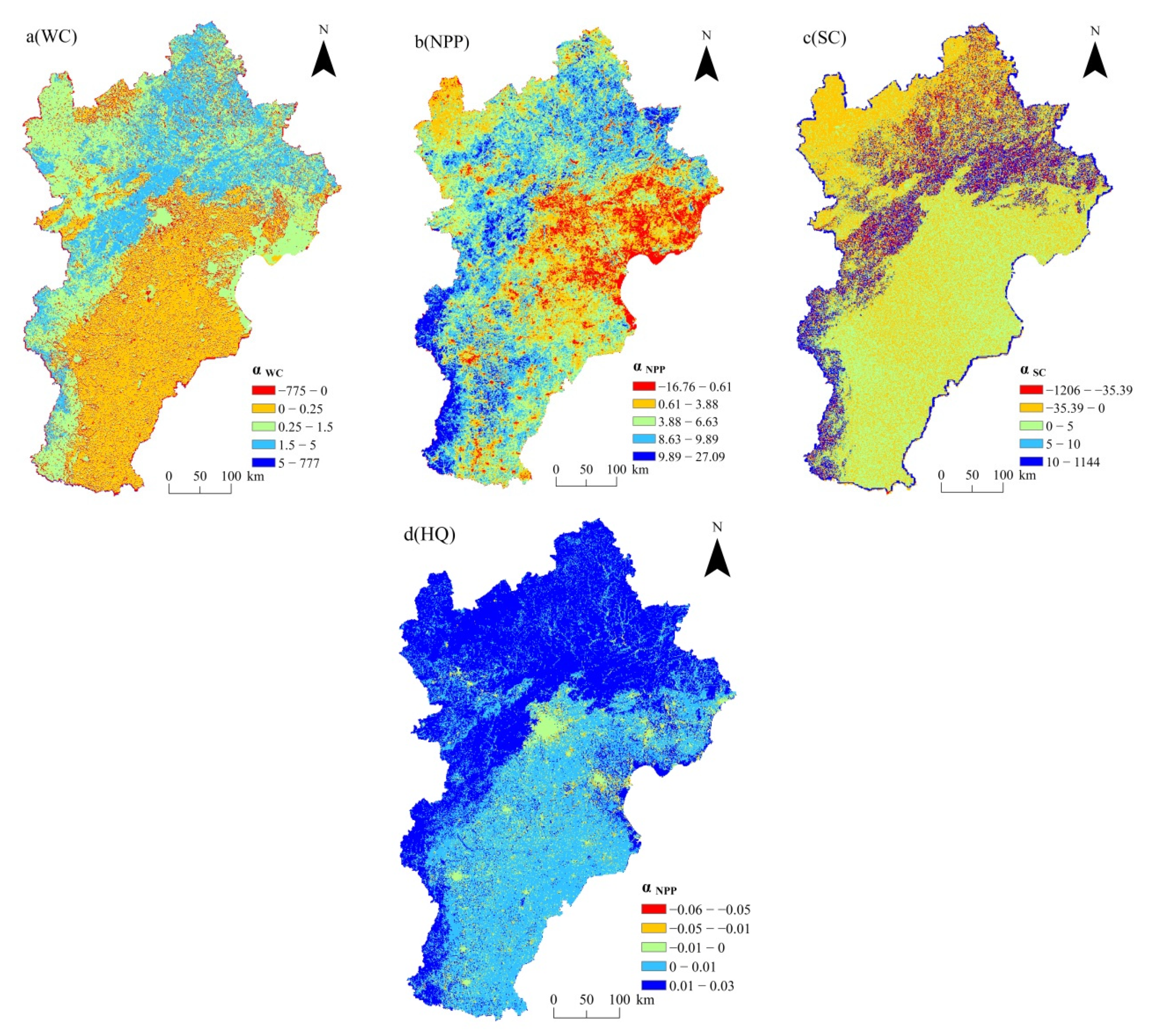
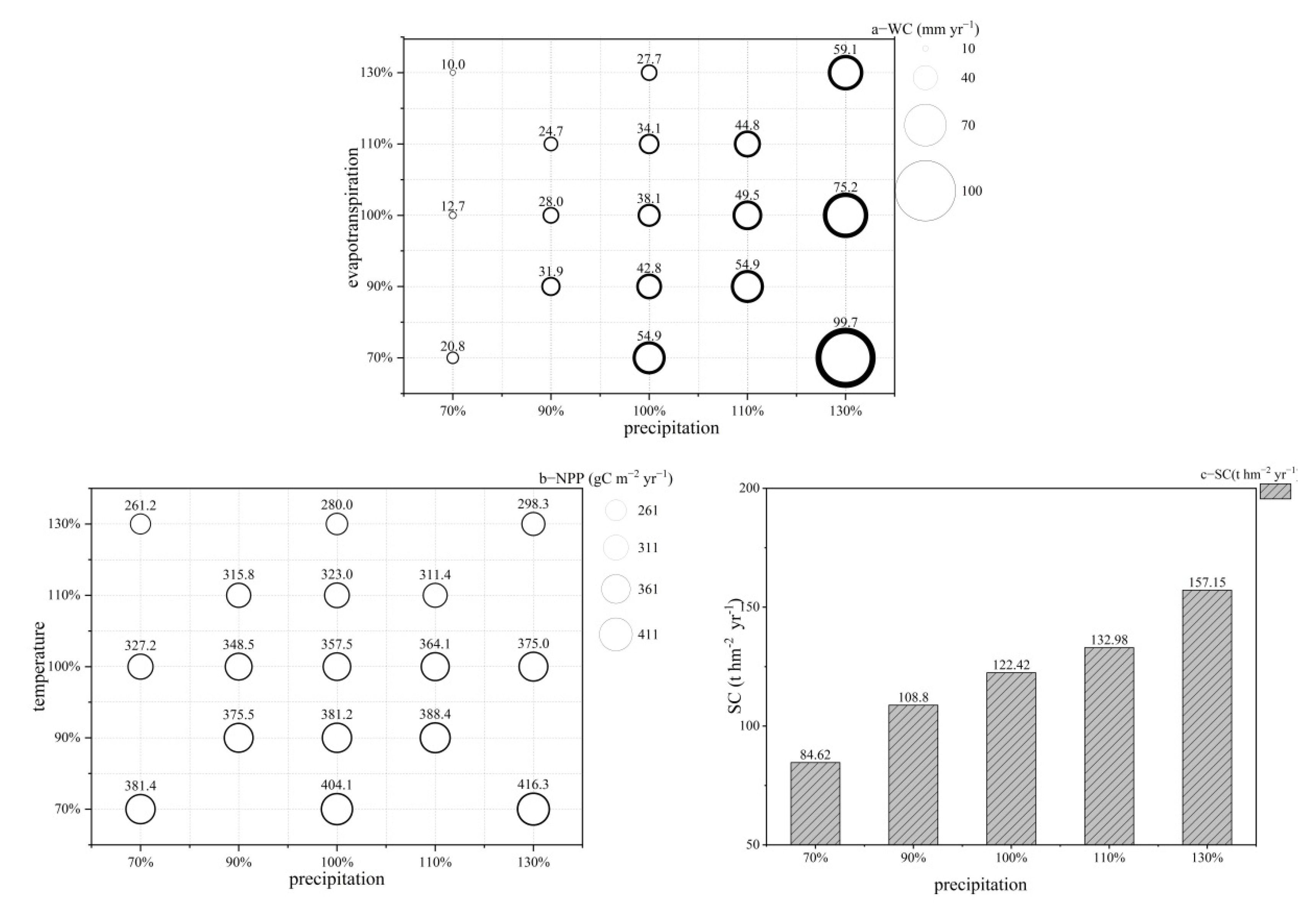
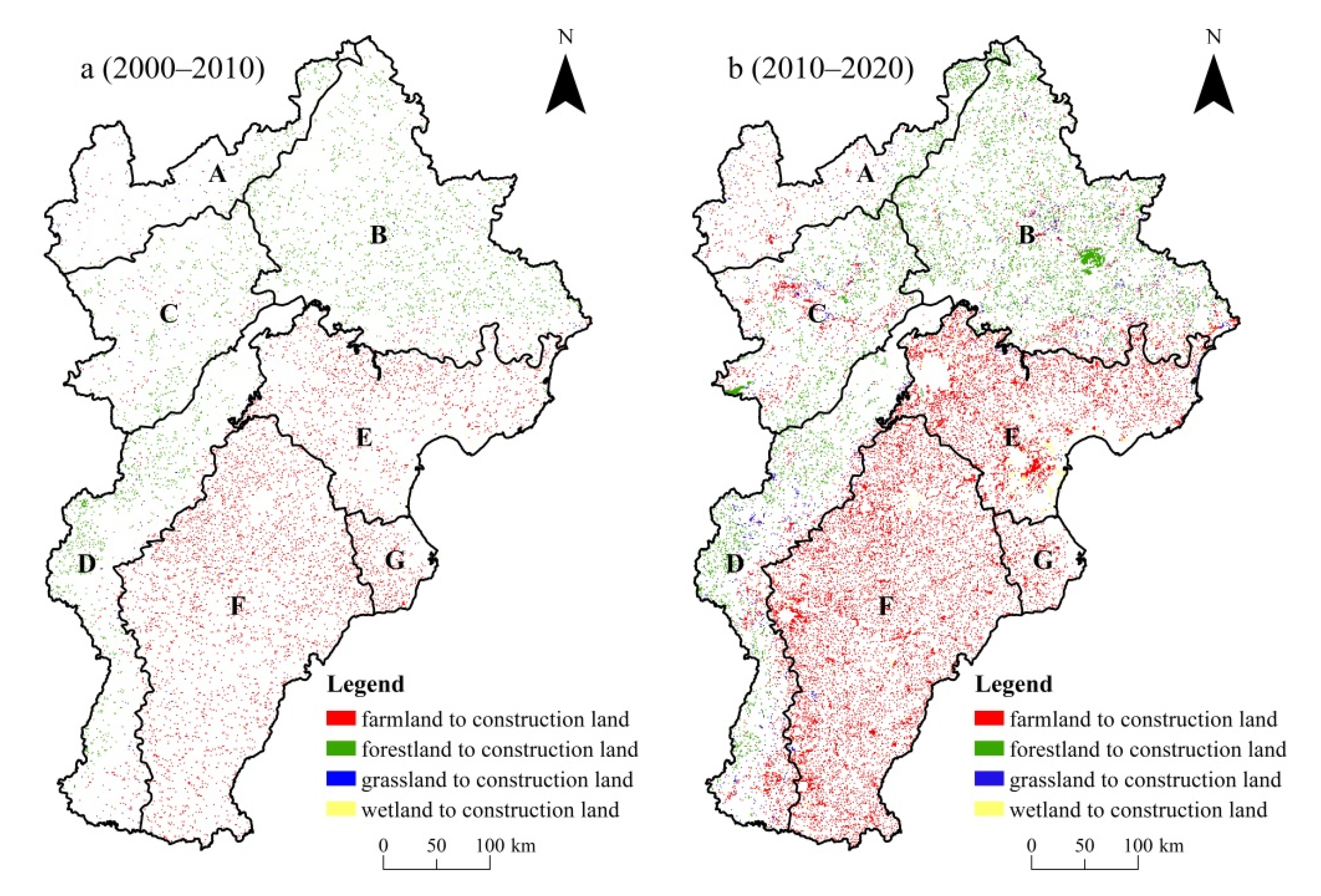
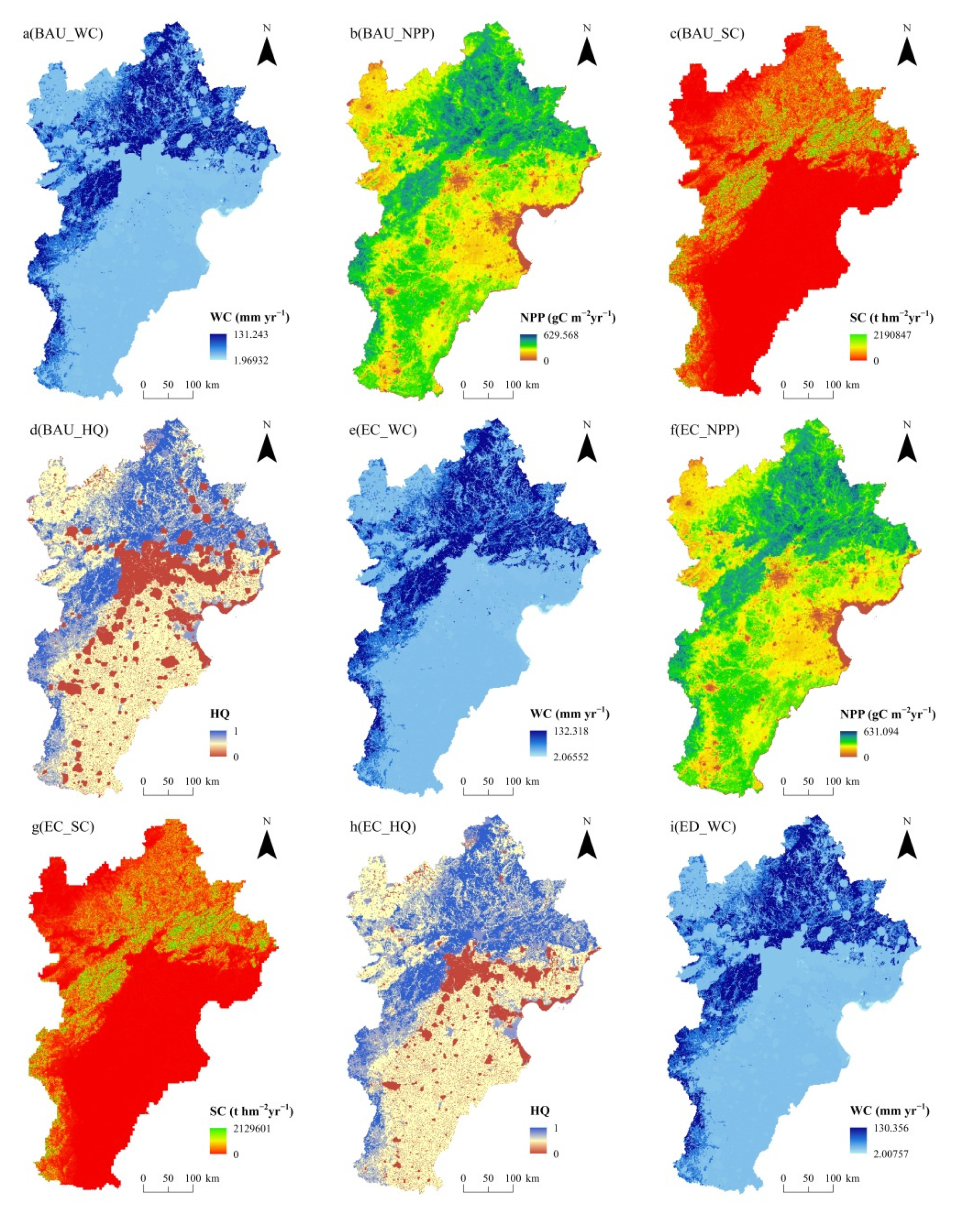
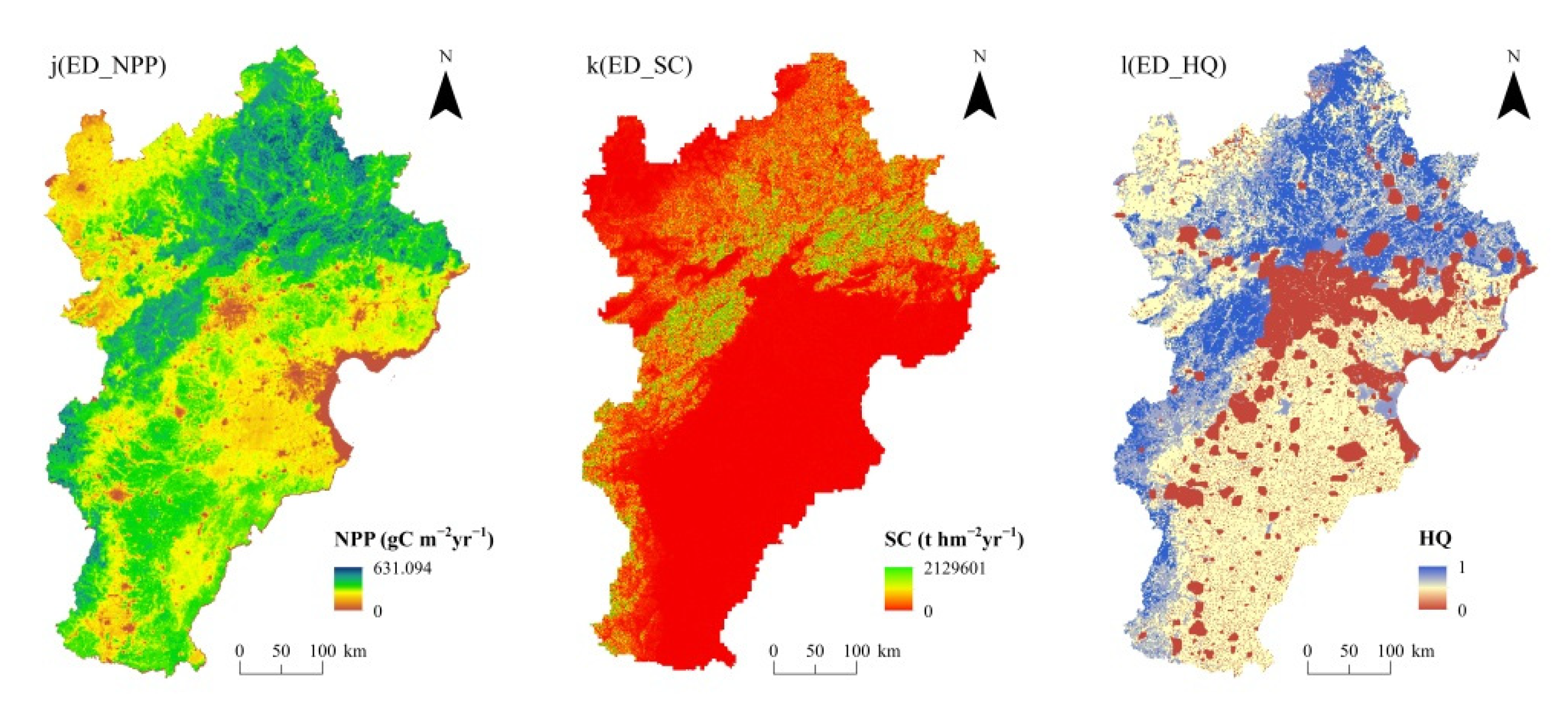
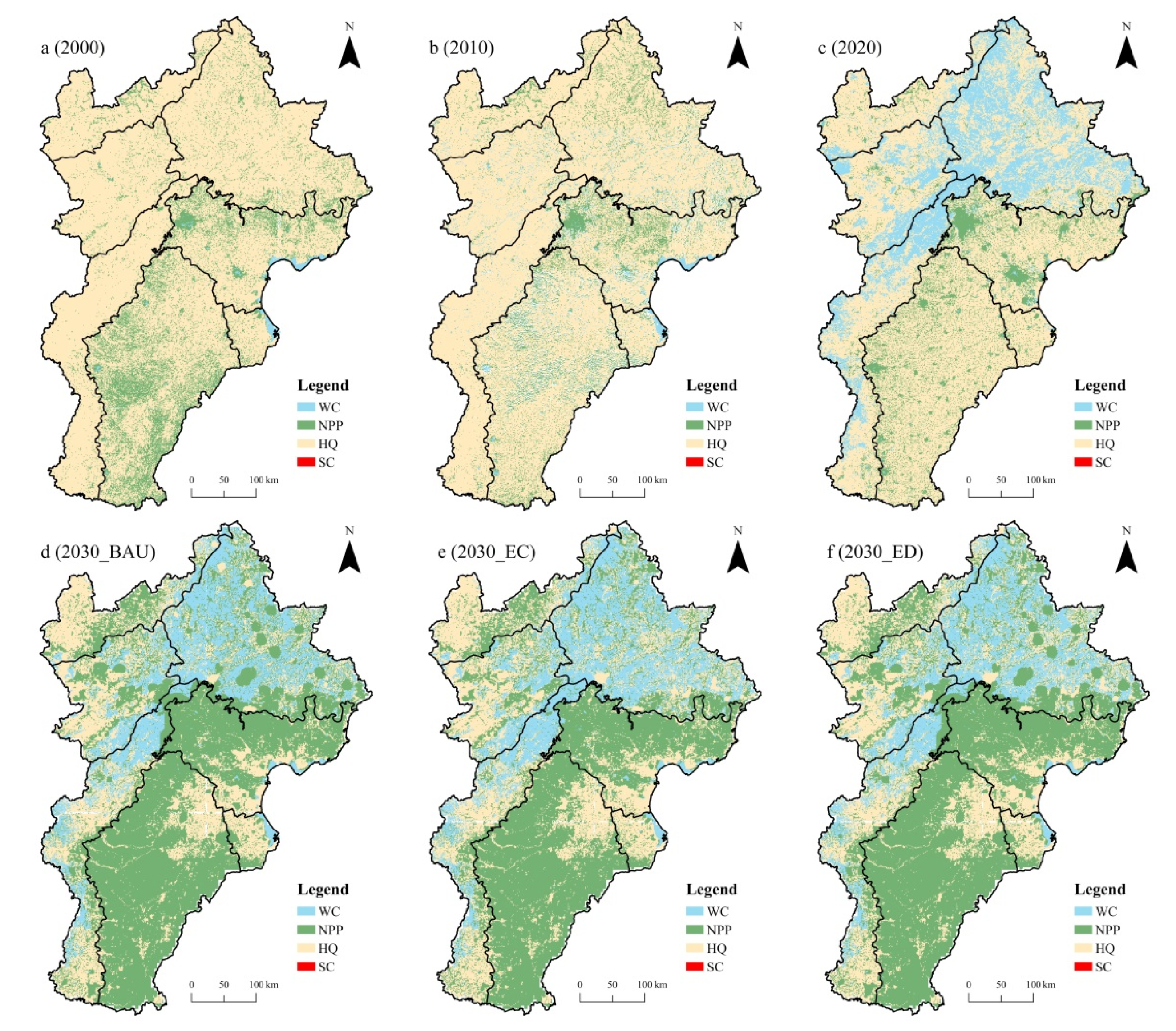
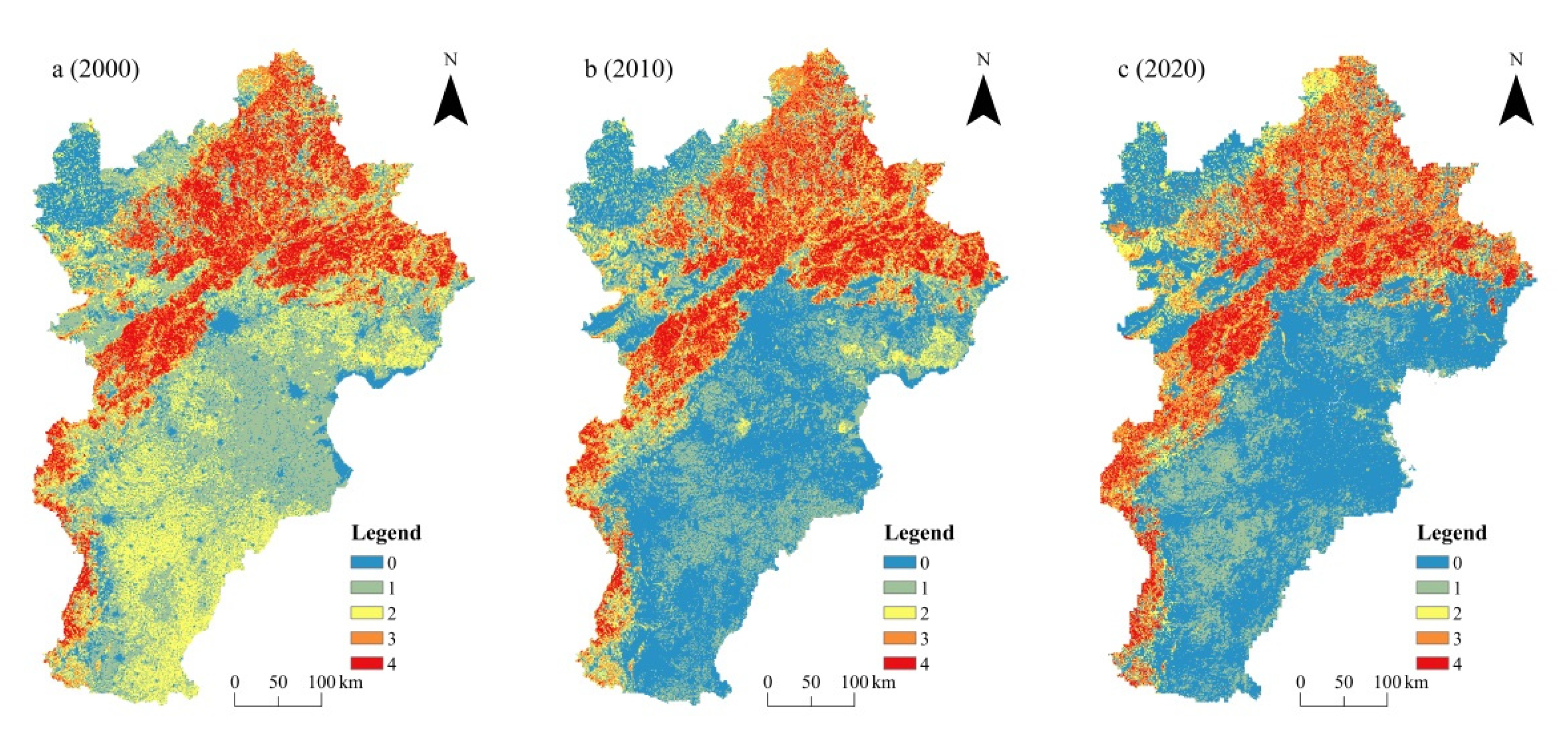
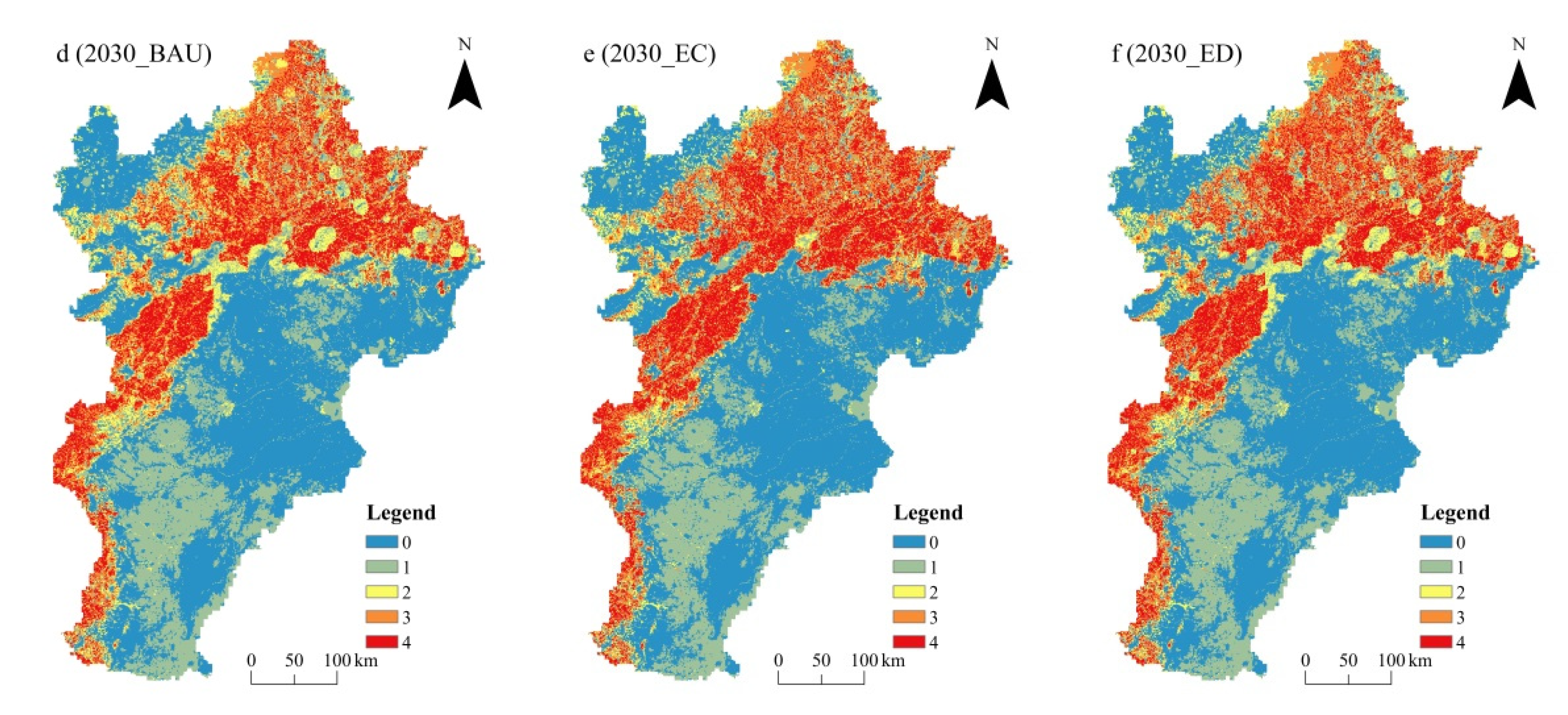
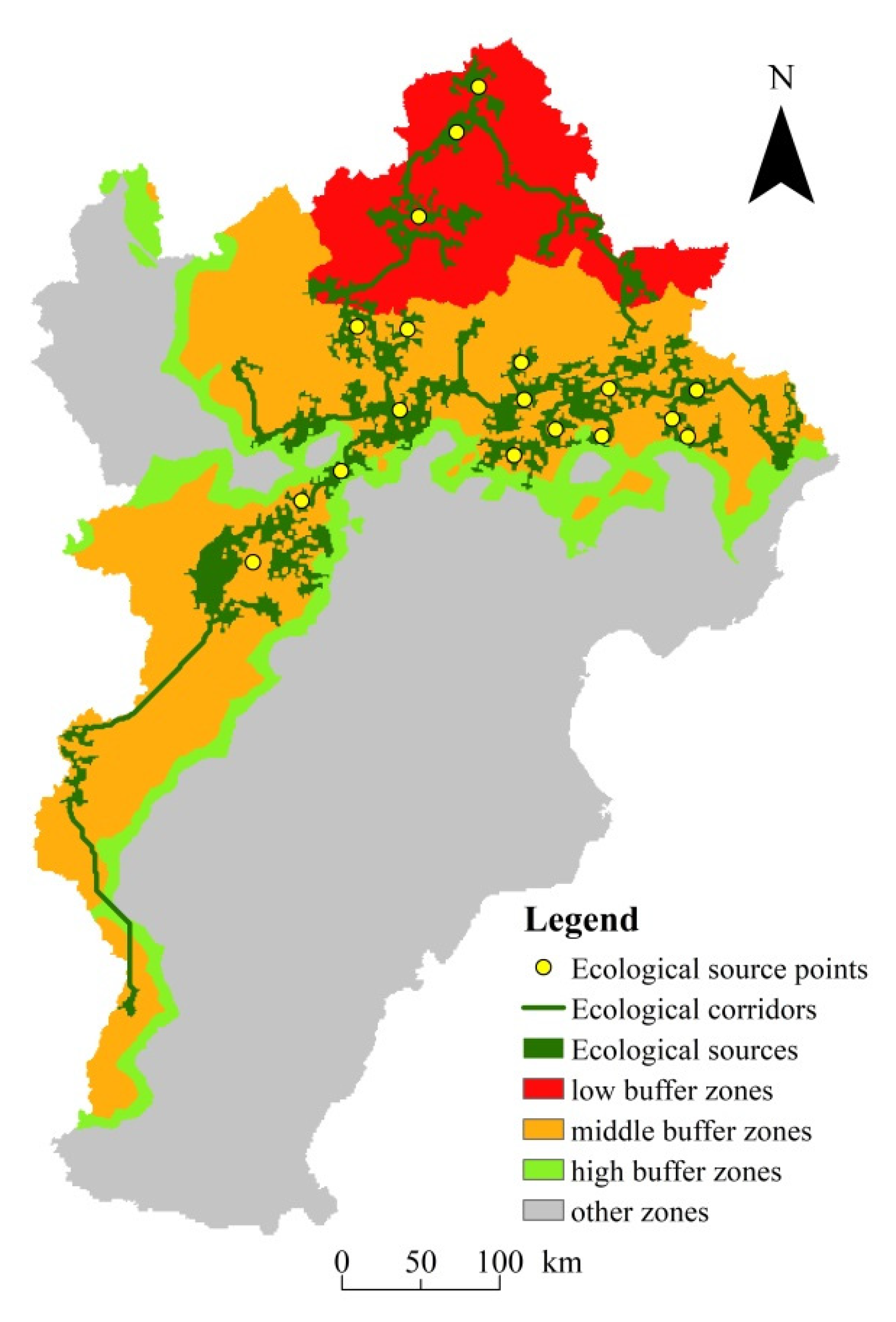
| Datasets | Information | Resolution | Period | Sources |
|---|---|---|---|---|
| Meteorological data | The meteorological data are rasterized by Kriging | Raster; 1000 m | 2000–2020 | China Meteorological Data Service Centre (http://data.cma.cn/) (accessed on 9 March 2021) |
| NDVI | MODIS13Q1 | Raster; 250 m | 2000–2020 | NASA (https://ladsweb.modaps.eosdis.nasa.gov/) (accessed on 3 September 2021) |
| Land Use | Chinese multi-period land use and land cover remote sensing monitoring dataset | Raster; 100 m | 2000\2005\2010\2015\2020 | Resource and Environment Science and Data Center (http://www.resdc.cn/) (accessed on 15 June 2021) |
| Soil | China soil database | Vector; 1:1,000,000 | - | The Nanjing Institute of soil research, CAS (http://www.issas.cas.cn/) (accessed on 3 March 2021) |
| DEM | SRTM DEM | Raster; 90 m | 2000 | Geospatial data cloud (http://www.gscloud.cn/) (accessed on 3 September 2021) |
| Road | Chinese road vector dataset | Vector; 1:1,000,000 | 2019 | National catalogue service for geographic information (http://mulu.tianditu.gov.cn) (accessed on 17 August 2021) |
| Water Resources | Water Resources Bulletin | statistics | 2000–2020 | Haihe River water conservancy commission (http://www.hwcc.gov.cn/) (accessed on 25 October 2021) |
| ESs | Model | Parameter Setting and Processing | Literature Source |
|---|---|---|---|
| WC | InVEST (water yield) | Based on the simulation results of water yield using the InVEST Model, the WC can be calculated by combining the water production with the topographic index, soil saturated hydraulic conductivity, runoff velocity coefficient, and other parameters | [45] |
| SC | InVEST (SDR) | Rainfall erosivity factor is calculated by Wischmeier’s monthly scale formula; Soil erodibility factor is calculated by soil erodibility estimation model; Vegetation and management factor C and soil and water conservation measure factor P are set by referring to relevant literature | [46,47,48] |
| HQ | InVEST (habitat quality) | The habitat threat sources include cultivated land, construction land, and traffic land, which are extracted from the land use data with a resolution of 100 m. The habitat threat sources and sensitivity parameters are set by referring to the relevant literature in Beijing, Tianjin, and Hebei | [49] |
| NPP | CASA | The monthly maximum light energy of different vegetation types refer to the research results on the calculation of the light energy utilization in China | [50,51] |
| LUCC Type | Base Line Data in 2015 | Land Requirement in 2030 | ||
|---|---|---|---|---|
| 2030(BAU) | 2030(EC) | 2030(ED) | ||
| Farmland | 108,698.57 | 94,931.55 | 103,467.78 | 94,632.20 |
| Forestland | 45,112.08 | 39,322.91 | 44,196.11 | 39,346.39 |
| Grassland | 35,285.66 | 30,151.51 | 32,808.36 | 30,216.79 |
| Wetland | 6181.02 | 8170.67 | 8432.45 | 8311.21 |
| Construction land | 20,710.12 | 42,823.47 | 27,275.64 | 43,673.76 |
| Unused land | 2012.54 | 2599.90 | 1819.66 | 1819.66 |
| Resistance Factor | Weight | Resistance Level and Coefficient | |||||
|---|---|---|---|---|---|---|---|
| National Highway | 0.094 | <0.5 km | 9 | 0.5–1 km | 7 | 1–2 km | 5 |
| 2–5 km | 3 | 5–10 km | 1 | >10 | 0 | ||
| Highway | 0.072 | <0.5 km | 9 | 0.5–1 km | 7 | 1–2 km | 5 |
| 2–5 km | 3 | 5–10 km | 1 | >10 | 0 | ||
| Railway | 0.061 | <0.5 km | 9 | 0.5–1 km | 7 | 1–2 km | 5 |
| 2–5 km | 3 | 5–10 km | 1 | >10 | 0 | ||
| DEM | 0.265 | <300 m | 1 | 300–600 m | 3 | 600–900 m | 5 |
| 900–1200 m | 7 | >1200 m | 9 | ||||
| Slop | 0.249 | <3° | 1 | 3–8° | 3 | 8–15° | 5 |
| 15–20° | 7 | >20 | 9 | ||||
| NDVI | 0.133 | 0–0.2 | 9 | 0.2–0.4 | 7 | 0.4–0.6 | 5 |
| 0.6–0.7 | 3 | >0.7 | 1 | ||||
| Land Use | 0.126 | Farmland | 5 | Forest land | 3 | Grassland | 5 |
| Wetland | 1 | Construction land | 9 | Unused land | 7 | ||
| Ecological Region | Temperature/°C a−1 | Precipitation/mm a−1 | Potential Evaporation/mm a−1 |
|---|---|---|---|
| A | −0.009 | 5.1404 | −3.5931 |
| B | −0.0156 | 3.8168 | −1.6437 |
| C | 0.0048 | 1.83 | −4.3579 |
| D | 0.0262 | 3.4299 | −8.1656 |
| E | 0.0168 | 5.7148 | −5.3265 |
| F | 0.0029 | 4.2436 | −2.6836 |
| G | 0.0059 | 5.0842 | −2.572 |
| BTH | 0.0028 | 4.0562 | −3.559 |
| 2020 | Farmland | Forestland | Grassland | Wetland | Construction Land | Unused Land | Transfer_Out | |
|---|---|---|---|---|---|---|---|---|
| 2000 | ||||||||
| Farmland | 83,440 | 4811 | 7042 | 2250 | 15,230 | 372 | 29,705 | |
| Forestland | 3854 | 33,740 | 6726 | 266 | 840 | 32 | 11,718 | |
| Grassland | 7015 | 7017 | 18,700 | 471 | 1287 | 206 | 15,996 | |
| Wetland | 1815 | 347 | 485 | 1897 | 744 | 476 | 3867 | |
| Construction land | 6616 | 247 | 362 | 1117 | 6241 | 51 | 8393 | |
| Unused land | 866 | 74 | 296 | 149 | 161 | 440.2 | 1546 | |
| Transfer_in | 20,165 | 12,495 | 14,912 | 4252 | 18,263 | 1137 | ||
| 2000 | 2010 | 2020 | 2030_BAU | 2030_EC | 2030_ED | |
|---|---|---|---|---|---|---|
| 0 | 13.78 | 38.65 | 45.53 | 45.53 | 41.43 | 41.21 |
| 1 | 33.29 | 22.29 | 15.17 | 15.17 | 21.28 | 19.78 |
| 2 | 26.15 | 11.76 | 11.36 | 11.36 | 9.29 | 8.14 |
| 3 | 12.50 | 14.28 | 14.93 | 14.93 | 11.94 | 13.18 |
| 4 | 14.28 | 13.03 | 13.01 | 13.01 | 16.07 | 17.70 |
Publisher’s Note: MDPI stays neutral with regard to jurisdictional claims in published maps and institutional affiliations. |
© 2022 by the authors. Licensee MDPI, Basel, Switzerland. This article is an open access article distributed under the terms and conditions of the Creative Commons Attribution (CC BY) license (https://creativecommons.org/licenses/by/4.0/).
Share and Cite
Wang, S.; Li, W.; Li, Q.; Wang, J. Ecological Security Pattern Construction in Beijing-Tianjin-Hebei Region Based on Hotspots of Multiple Ecosystem Services. Sustainability 2022, 14, 699. https://doi.org/10.3390/su14020699
Wang S, Li W, Li Q, Wang J. Ecological Security Pattern Construction in Beijing-Tianjin-Hebei Region Based on Hotspots of Multiple Ecosystem Services. Sustainability. 2022; 14(2):699. https://doi.org/10.3390/su14020699
Chicago/Turabian StyleWang, Sheng, Wenjing Li, Qing Li, and Jinfeng Wang. 2022. "Ecological Security Pattern Construction in Beijing-Tianjin-Hebei Region Based on Hotspots of Multiple Ecosystem Services" Sustainability 14, no. 2: 699. https://doi.org/10.3390/su14020699
APA StyleWang, S., Li, W., Li, Q., & Wang, J. (2022). Ecological Security Pattern Construction in Beijing-Tianjin-Hebei Region Based on Hotspots of Multiple Ecosystem Services. Sustainability, 14(2), 699. https://doi.org/10.3390/su14020699






